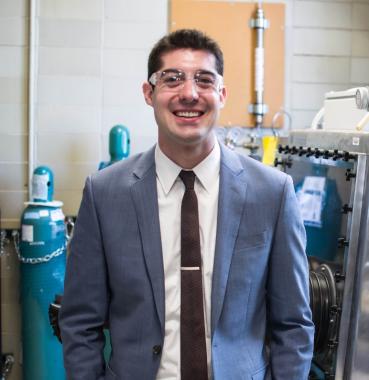TOPIC: Reaction engineering in planta? Tales of mass transfer limitations and their kinetic consequences at the mesoscale for next-generation biorefining
SPEAKER: Nicholas E. Thornburg, PhD
DATE: Tuessday, November 29th, 2022
TIME: 6:00 pm - Introduction
6:05 pm - Career Discussion
6:15 pm - Technical Presentation
7:15 pm - Q & A
COST: Free, Registration Required
LOCATION: On-line Zoom Meeting
ABSTRACT: Between the molecular and reactor scales—familiar favorites to the chemical engineering community—lies an intermediate regime termed the “mesoscale” where chemical reaction kinetics and transport phenomena compete along similar time and length scales. However, little is known about the coupled chemistry and physics of biomass conversion at the mesoscale, which govern effective rates of organic component extraction from plant cell walls during biorefinery feed fractionation processes. First, I will introduce an experimentally validated simulation framework that determines transport‐independent kinetic rate constants upon incorporating realistic feedstock characteristics for an exemplary hardwood solvolysis process. This generalizable mesoscale reaction–diffusion modeling approach will then be extended to validate and predict the alkaline deacetylation of corn stover, an emerging biorefinery pretreatment method that removes acetyl from hemicellulose prior to mechanical refining to improve downstream enzymatic sugar yields. Reaction–diffusion models are developed and validated for three major anatomical fractions (cobs, husks and stalks), and model findings categorize experimental feedstock performance into kinetic-controlled vs. diffusion-controlled regimes based on the particle size and microstructural attributes of each tissue type. Critically, the model predicts that typical corn stover particles as small as ~2.3 mm in length are entirely diffusion-limited for acetate extraction, with experimental effectiveness factors calculated to be 0.50 for such processes. Overall, this presentation highlights opportunities to improve biomass fractionation and conversion via reaction engineering and provides actionable kinetic information to guide the design and scale‐up of emerging biorefinery strategies.
SPEAKER BIOGRAPHY: Dr. Nicholas (Nick) Thornburg is a chemical reaction engineer in the Fuels and Combustion Science group within the Center for Integrated Mobility Sciences (CIMS) at the National Renewable Energy Laboratory (NREL). Nick joined CIMS in April 2020 and began his current role as a staff research engineer in October of the same year. He originally joined NREL’s National Bioenergy Center (NBC) as a postdoctoral researcher in April 2017, where he studied particle-scale reaction engineering and multiphase chemical reactor design and optimization for biomass deconstruction. Nick’s current research interests lie in multiphase reaction engineering for onboard fuel reforming and emissions management applications and for the renewable synthesis of small-molecule chemicals and fuels, such as ammonia. Nick has a Bachelor of Science in Chemical Engineering from Washington University St. Louis and a Doctorate in Chemical Engineering from Northwestern University. His doctoral research at Northwestern focused on understanding heterogeneous transition metal oxide catalysts for applications in sustainable chemical manufacturing. Before joining NREL, Nick gained industrial research and development experience with The Dow Chemical Company and 3M.
- Log in to post comments
